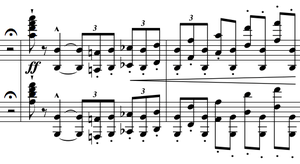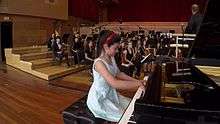Piano Concerto No. 1 (Liszt)

Franz Liszt composed his Piano Concerto No. 1 in E-flat major, S.124 over a 26-year period; the main themes date from 1830, while the final version is dated 1849. The concerto consists of three movements and lasts approximately 20 minutes. It premiered in Weimar on February 17, 1855, with Liszt at the piano and Hector Berlioz conducting.
History
The main themes of Liszt's first piano concerto are written in a sketchbook dated 1830, when Liszt was nineteen years old. He seems to have completed the work in 1849, yet made further adjustments in 1853. It was first performed at Weimar in 1855, with the composer at the piano and Hector Berlioz conducting. Liszt made yet more changes before publication in 1856. Béla Bartók described it as "the first perfect realisation of cyclic sonata form, with common themes being treated on the variation principle".
Form
The concerto consists of four relatively short movements:
- Allegro maestoso
 The first entrance in the first movement introduces a motive that is revisited several times.
The first entrance in the first movement introduces a motive that is revisited several times.- The orchestra introduces the main theme of the piece with a powerful motif.[1] It is said that the main theme was set to the words "None of you understand this, haha!" (German: “Das versteht ihr alle nicht, haha!”) to deter any criticism from critics who did not like the piece's originality.[2] The piano then comes in with an octave passage, spanning 4 octaves.
- A duet is formed between the piano and the clarinet in a quiet and peaceful passage, yet this is soon taken over again by the main theme. Following this, the piano plays fast, downward chromatic octaves, before recapitulating a section from earlier in the movement, this time in G major. The movement finishes with the main theme played by the strings while the piano imitates a harp with fast, quiet arpeggios, culminating with an upwards chromatic scale in sixths, diminishing to ppp volume.
 Franz Liszt (1811-1886) - Piano Concerto 1, S124 - I Allegro maestoso
Franz Liszt (1811-1886) - Piano Concerto 1, S124 - I Allegro maestoso
- Quasi adagio
- The cellos and double basses introduce the Adagio section in a serene, unison cantabile, before the rest of the string section joins. Again, however, the cellos and double basses descend before the piano joins, in una corda. The piano uses the string theme and develops it further, playing in a nocturne-like style with soft, flowing left hand arpeggios and a cantibile melody in the right hand. The section reaches a climax where a strong fortissimo is played followed by a descending diminuendo scale.
- After a slight general pause, the whole orchestra joins, again playing the same theme. Then a cello plays the theme while the piano answers quickly and hurriedly with a developmental recitative section. This leads into a passage where solos in the woodwind section play a new theme while the piano plays long trills in the right hand and spread chords in the left. The passage is ended by the piano and clarinet in duet.
- Allegretto vivace - Allegro animato
- The triangle starts the movement with a string quartet following it. Next, the piano plays the same theme, yet develops it further. This occurs over the whole movement, however previous themes from the last two movements are re-introduced and combined together to give this concerto its unique rhapsody-like form. This movement is decidedly joking in character, with the performance direction at the start of the piano line of "capriccioso scherzando", and delicate, playful duets between the woodwind and piano occurring throughout. The second half of the movement, however, takes a darker turn, when the piano, after concluding the scherzo section, plays an eerie, tremolando passage in the lower registers, with a development of the first theme played above, at pp dynamic. After this, the downward chromatic octaves reappear, but this time at p level, before the orchestra plays an ascending chromatic section, leading into a tonal recapitulation of the first theme. The movement ends with very similar music as the first movement begins, with a blistering piano passage ending in a F-diminished chord.
- Allegro marziale animato
- A descending E-flat major scale is played before the orchestra plays a new theme, the final of the concerto. The piano follows this with a blistering solo octaves passage before joining in duet with various solo woodwind instruments in a dainty, lively section, leading onto the rest of the movement, which many consider to be among the hardest music ever written for piano.
- The movement continues bringing out all the themes from throughout the concerto at different times and combining them sequentially.
- In the final few passages, new chromatic theme is introduced where the piano is playing semi-quavers and tripleted quavers at the same time, an exercise in polyrhythm, while in unison with the strings.
- The piece is finished in the bravura style for which Liszt is famous, with the now-familiar downward chromatic octaves theme, played in this recapitulation at breakneck presto speed, before changing to contrary chromatic octaves, reaching the tonic key of E-flat major and fff dynamic. The orchestra alone has the last two notes, which Liszt carefully utilised to highlight the importance of the orchestra in the piece, not just as an accompanying device for the piano.
Orchestration
This concerto is scored for a relatively small Romantic orchestra and calls for the following instruments:
- Solo Piano
- Strings
- Violins I, II
- Violas
- Cellos
- Double basses
See also
References
- ↑ Hamilton, Kenneth (2005). The Cambridge Companion to Liszt. Cambridge Companions to Music. Cambridge University Press. p. 162. ISBN 0-521-62204-2.
- ↑ Maki, Daniel. "Concert notes". Archived from the original on 2008-10-15. Retrieved 2015-12-24.
External links
- Franz Liszt's Piano Concerto No. 1 Analysis and description of Franz Liszt's Piano Concerto No. 1 in E Flat Major
- Piano.ru - Sheet music download (2 piano reduction)
- Piano Concerto No. 1: Scores at the International Music Score Library Project